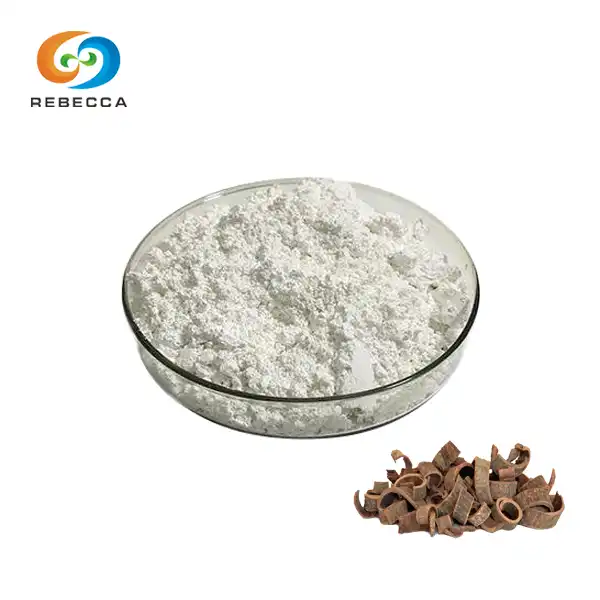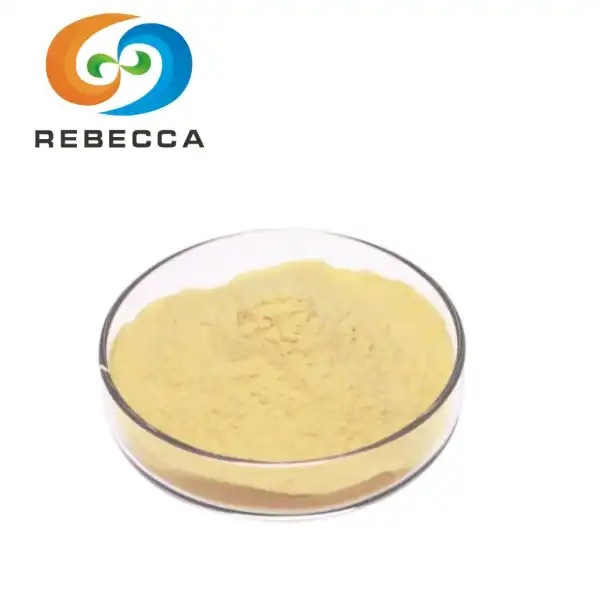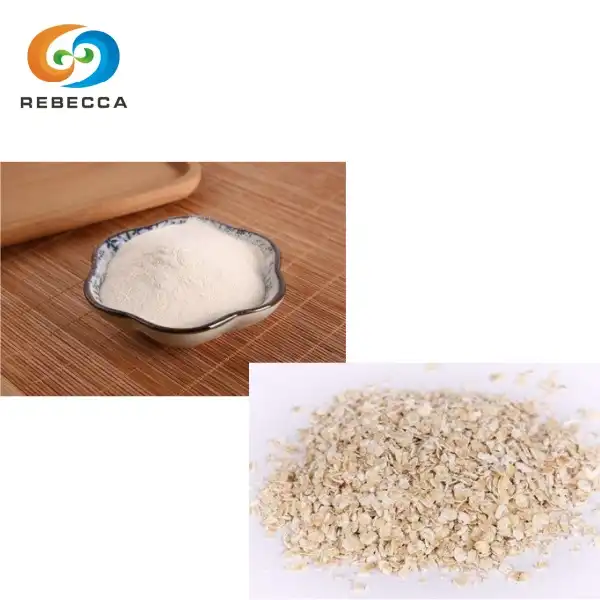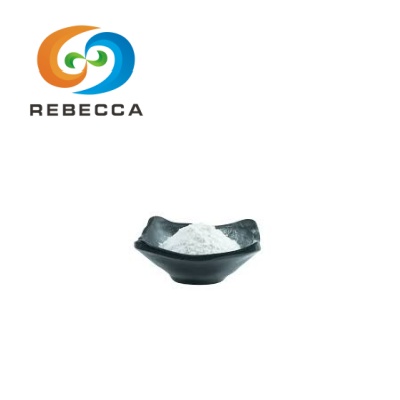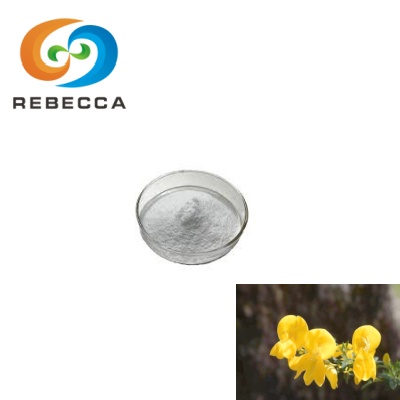What is propyl gallate in food?
propyl gallate plays a crucial role in extending the shelf life of various food products, ensuring they maintain their quality and freshness for longer periods. But what exactly is propyl gallate powder, and how does it work its magic in our food? Let's dive into the fascinating world of this food additive and explore its functions, applications, and safety considerations.
_1730079799361.webp)
Propyl Gallate
【English name】: Propyl Gallate
【CAS No.】: 121-79-9
【Molecular Formula】:C10H12O5
【Plant Source】: Gallnut
【active ingredients】: Propyl Gallate
【Specification】: Propyl Gallate 98%
【Appearance】: White to light beige powder
Function: Antioxidant
Propyl gallate, also known by its chemical name propyl 3,4,5-trihydroxybenzoate, is a synthetic antioxidant derived from gallic acid. Its primary function in food is to prevent oxidation, a process that can lead to rancidity, color changes, and loss of nutritional value in food products.
When fats and oils in food are exposed to oxygen, they can undergo a chemical reaction called oxidation. This process not only affects the taste and smell of food but can also lead to the formation of harmful compounds. Propyl gallate works by interrupting the oxidation chain reaction, effectively slowing down the degradation process and preserving the food's quality.
The antioxidant properties of propyl gallate powder are particularly valuable in foods with high fat content, as these are most susceptible to oxidation. By adding propyl gallate to these products, manufacturers can significantly extend their shelf life, maintain their flavor profile, and ensure that consumers receive a product that's as fresh and nutritious as possible.

Common Food Applications
Propyl gallate finds its way into a wide array of food products, thanks to its effectiveness and versatility. Some common applications include:
1. Edible oils and fats: Propyl gallate powder is often added to vegetable oils, animal fats, and margarine to prevent them from becoming rancid.
2. Baked goods: It helps preserve the freshness of cookies, crackers, and other baked products that contain fats or oils.
3. Snack foods: Many potato chips, nuts, and other snack items benefit from propyl gallate's antioxidant properties.
4. Chewing gum: The additive helps maintain the flavor and texture of gum over time.
5. Meat products: Propyl gallate can be used in processed meats to prevent oxidation and maintain color.
6. Cosmetics and personal care products: While not a food application, it's worth noting that propyl gallate is also used in these products to extend their shelf life.
The versatility of propyl gallate powder makes it an invaluable tool for food manufacturers looking to enhance the stability and longevity of their products. Its ability to work effectively in various food matrices has made it a go-to antioxidant in the food industry.
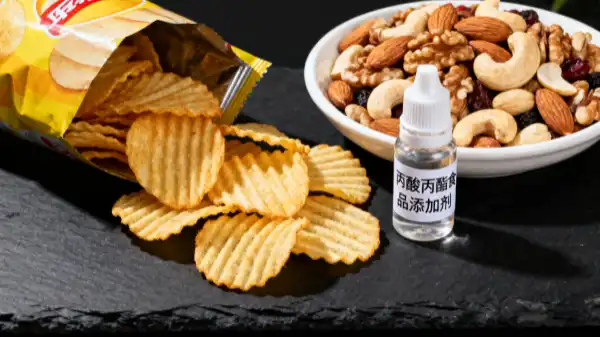
Safety and Regulatory Considerations
As with any food additive, safety is paramount when it comes to propyl gallate. The good news is that extensive research and regulatory scrutiny have deemed propyl gallate safe for use in food products when used within established limits.
In the United States, the Food and Drug Administration (FDA) has approved propyl gallate as a food additive. It's classified as "Generally Recognized as Safe" (GRAS) when used in accordance with good manufacturing practices. The European Food Safety Authority (EFSA) has also evaluated propyl gallate and established an Acceptable Daily Intake (ADI) for its use in food.
However, it's important to note that regulatory bodies continually review and update their guidelines based on new scientific evidence. As of now, propyl gallate powder is considered safe when used within the prescribed limits, which typically range from 0.01% to 0.02% of the fat or oil content of the food.
While propyl gallate powder is generally well-tolerated, some individuals may be sensitive to it. As with any food ingredient, those with specific allergies or sensitivities should check product labels and consult with their healthcare provider if they have concerns.
It's worth mentioning that propyl gallate is often used in combination with other antioxidants, such as BHA (butylated hydroxyanisole) and BHT (butylated hydroxytoluene), to achieve synergistic effects. This combination approach allows manufacturers to use lower amounts of each antioxidant while still achieving the desired preservative effect.

Science Behind Propyl Gallate
To truly appreciate the role of propyl gallate in food preservation, it's helpful to understand its molecular structure and how it functions at a chemical level. Propyl gallate (C10H12O5) is a phenolic compound with a molecular formula that gives it its potent antioxidant properties.
The compound's structure allows it to donate hydrogen atoms to free radicals, effectively neutralizing these reactive molecules that can cause oxidation. This process interrupts the chain reaction of oxidation, preventing the formation of peroxides and other undesirable compounds that can affect food quality.
Its effectiveness of an antioxidant is also influenced by its solubility. It's fat-soluble, which means it can easily incorporate into the fatty portions of food products where oxidation is most likely to occur. This characteristic makes it particularly useful in preserving oils, fats, and fat-containing foods.
Research has shown that propyl gallate is most effective when used in combination with other antioxidants. For example, when used alongside BHA and BHT, it can provide superior protection against oxidation compared to using any of these antioxidants alone. This synergistic effect allows food manufacturers to achieve optimal preservation while using lower concentrations of each individual antioxidant.
Propyl Gallate Powder Supplier: Rebecca Bio-Tech
As we've explored its importance and applications in food preservation, it's crucial to source this valuable ingredient from a reputable supplier. Rebecca Bio-Tech stands out as a leading provider of high-quality products, offering a product that meets the highest standards of purity and effectiveness.
Rebecca Bio-Tech's propyl gallate powder (CAS No. 121-79-9) is derived from natural gallnut, ensuring a consistent and reliable source of this essential antioxidant. With a specification of 98% purity and a white to light beige powder appearance, their product meets the exacting requirements of food manufacturers worldwide.
As a high-tech, export-oriented company, Rebecca Bio-Tech specializes in the production, research, and development of plant extracts, herbal active ingredient separation, and traditional Chinese herbal medicine functional compound research. Their dedication to quality and innovation makes them an ideal partner for businesses seeking top-tier propyl gallate powder for their food preservation needs.
To learn more about Rebecca Bio-Tech's product and how it can benefit your food products, don't hesitate to reach out. Contact them at information@sxrebecca.com for detailed product information, pricing, and expert advice on incorporating this powerful antioxidant into your formulations.
FAQ
Q1: Is propyl gallate safe for consumption?
A: Yes, propyl gallate is considered safe for consumption when used within the prescribed limits set by regulatory bodies like the FDA and EFSA. It has undergone extensive safety evaluations and is classified as Generally Recognized as Safe (GRAS) by the FDA when used in accordance with good manufacturing practices.
Q2: Can propyl gallate be used in organic food products?
A: No, propyl gallate is a synthetic antioxidant and is not allowed in certified organic food products. Organic food manufacturers typically use natural alternatives like rosemary extract or tocopherols for preservation purposes.
Q3: How does propyl gallate compare to other synthetic antioxidants like BHA and BHT?
A: Propyl gallate is often used in combination with BHA and BHT for synergistic effects. While all three are effective antioxidants, propyl gallate is particularly effective in fats and oils. The choice between these antioxidants often depends on the specific food application, desired shelf life, and regulatory considerations.
References
1. U.S. Food and Drug Administration (FDA). Food Additives Status List. U.S. Department of Health and Human Services.
2. European Food Safety Authority (EFSA). (2014). Scientific Opinion on the re-evaluation of propyl gallate (E 310) as a food additive.
3. Joint FAO/WHO Expert Committee on Food Additives (JECFA). (2001). Evaluation of Certain Food Additives and Contaminants. WHO Technical Report Series 901. World Health Organization, Geneva.
4. Shahidi, F., & Zhong, Y. (2015). Measurement of antioxidant activity in food and biological systems.
5. Pokorný, J. (2007). Are natural antioxidants better – and safer – than synthetic antioxidants?
